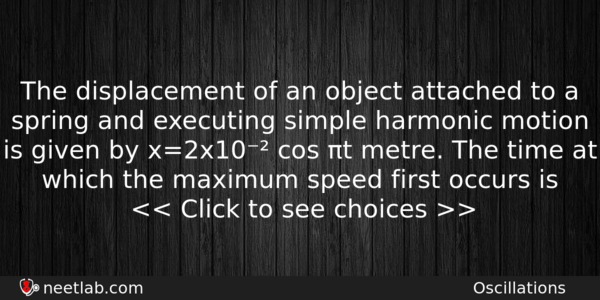| ⇦ | 
| ⇨ |
The displacement of an object attached to a spring and executing simple harmonic motion is given by x=2×10⁻² cos πt metre. The time at which the maximum speed first occurs is
Options
(a) 0.25 s
(b) 0.5 s
(c) 0.75 s
(d) 0.125 s
Correct Answer:
0.5 s
Explanation:
No explanation available. Be the first to write the explanation for this question by commenting below.
Related Questions: - The ratio of the dimensions of planck’s constant and that of the moment of inertia is
- If we study the vibration of a pipe open at both ends
- The refractive index of water, glass and diamond are 1.33, 1.50, 2.40 respectively
- The total energy of a particle executing SHM is 80 J
- The average power dissipated in AC circuit is 2 W. If a current flowing through
Topics: Oscillations
(58)
Subject: Physics
(2479)
Important MCQs Based on Medical Entrance Examinations To Improve Your NEET Score
- The ratio of the dimensions of planck’s constant and that of the moment of inertia is
- If we study the vibration of a pipe open at both ends
- The refractive index of water, glass and diamond are 1.33, 1.50, 2.40 respectively
- The total energy of a particle executing SHM is 80 J
- The average power dissipated in AC circuit is 2 W. If a current flowing through
Topics: Oscillations (58)
Subject: Physics (2479)
Important MCQs Based on Medical Entrance Examinations To Improve Your NEET Score
18000+ students are using NEETLab to improve their score. What about you?
Solve Previous Year MCQs, Mock Tests, Topicwise Practice Tests, Identify Weak Topics, Formula Flash cards and much more is available in NEETLab Android App to improve your NEET score.
Share this page with your friends

Leave a Reply